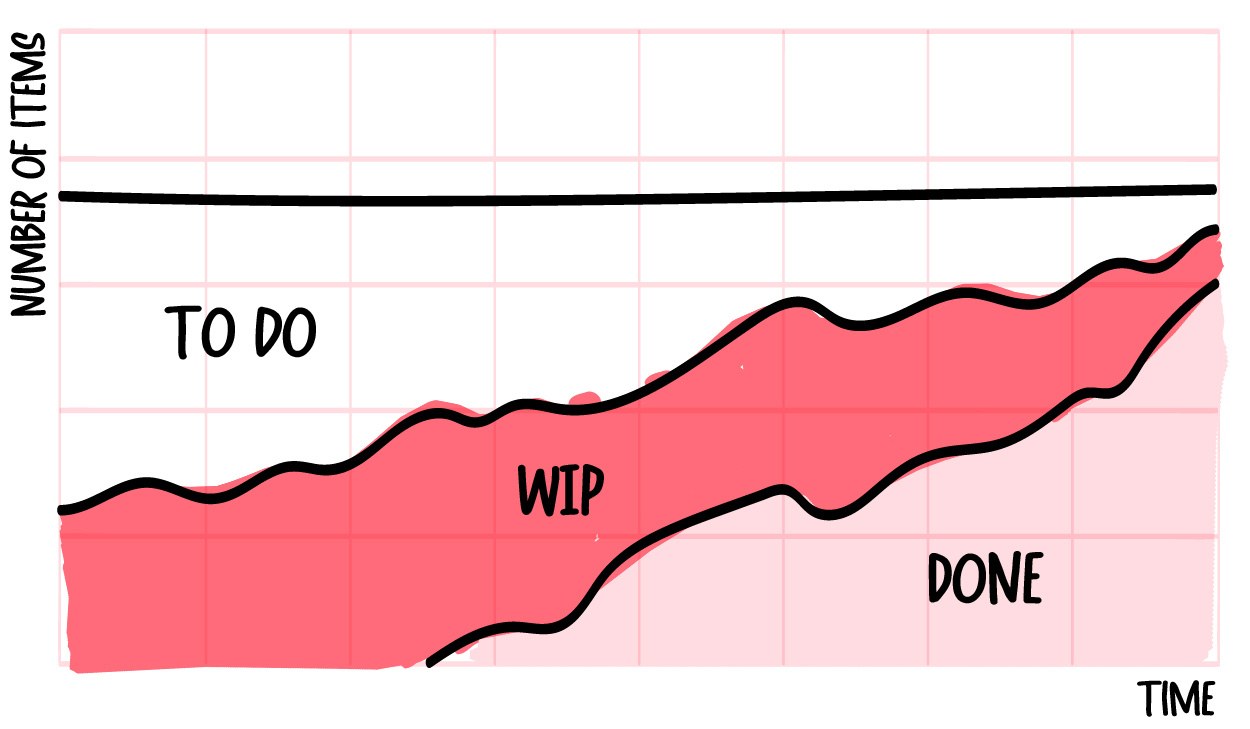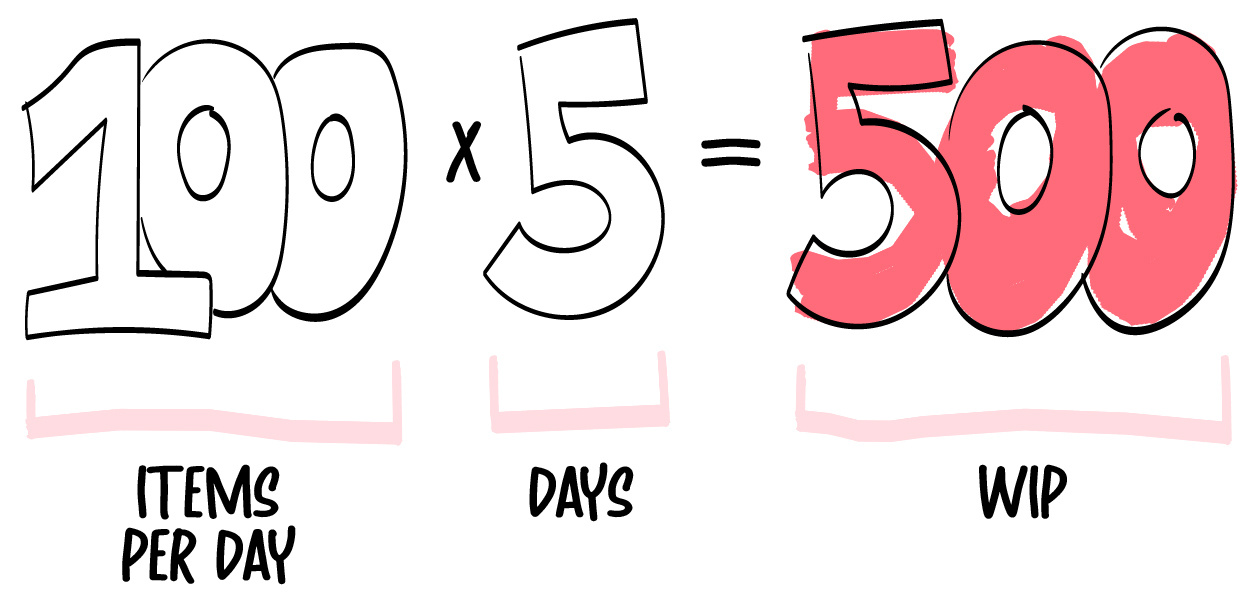
A weekly newsletter exploring the intersection of creative operations, technology, and online retail.
#005: Cutting Through Complexity: The KPI You Didn’t Know You Needed
Content production has become a complex juggling act. With deadlines tightening, assets piling up, and communication stretched across teams, keeping everything moving smoothly can feel near impossible.
And while more tools and systems promise to help, they often add to the pile, giving us even more to manage and track. Without clear checkpoints, quality can slip, and suddenly, re-doing work can become the norm rather than the exception.
However, one metric is crucial for reining in complexity: work in progress (WIP). Managing WIP can give you back control, reduce back-and-forth, and let your team focus more on the creative work they signed up for.
When WIP is measured and managed, studios see less rework, more flow, and a creative process that works with you, not against you. Imagine a team running smoothly, creating freely, and set up to deliver quality every time. That’s the future we’re all aiming for.
Why Work in Progress Matters for Complexity
The amount of WIP doesn't just influence complexity in a studio—WIP is the measurement of complexity. The more projects, tasks, and items we have in play, the greater the complexity and the higher the potential for inefficiencies downstream.
To understand studio complexity, we must first examine three fundamental metrics: throughput, speed, and WIP.
- Throughput is the number of products your team completes daily, representing overall efficiency.
- Speed is how long it takes to finish each item, showing your studio's turnaround time.
- WIP is the total number of items being worked on at any moment.
For instance, if your studio completes 100 items per day (throughput) and each item takes five days to finish (speed), your work in progress is 500 items.

Understanding this formula—WIP equals throughput times speed—is incredibly powerful for managing (and, if needed, improving) your studio's operations.
Yet, it’s something many teams overlook.
The Hidden Costs of Too Much WIP
I recently spoke with a studio manager who managed hundreds of product shoots. They meticulously tracked throughput and speed but couldn’t determine why things felt chaotic. The missing piece was WIP. All those unfinished tasks were sitting there, clogging up the system without contributing value.
When I ask studios about their WIPs, I’m often met with blank stares. As creatives, we often profess our desire to increase speed and improve efficiency, but it’s almost impossible to do so without considering how much is currently in progress.
Think of it like this: every task you’ve started but not finished is worth zero until it's done. More importantly, reducing WIP is like clearing the fog—you gain clarity, and suddenly, everything feels more straightforward to manage.
What's surprising is how impactful a slight focus shift can be. Studios that reduce WIP often see immediate gains in speed and efficiency. Why? WIP is a measure of complexity itself—when WIP goes down, complexity goes down, too.
Reducing WIP not only reduces complexity but also directly reduces waste in the studio. Rework, the worst waste, becomes less frequent as the studio becomes more streamlined.
With less complexity, mistakes are more avoidable, and when they do happen, they’re much simpler to fix. Switching costs—the other hidden waste—are also minimized, allowing the team to stay focused and productive.
If I want you to take anything away from this newsletter, it's this: less WIP, less complexity, and less waste—these may seem like minor adjustments, but they make a huge impact.
Making WIP a KPI: A Key Step Toward a Leaner Studio
In today’s high-volume production landscape, complexity often goes unchecked. But here’s the good news: complexity can be measured. Are you doing this today? If not, it’s something to consider because tracking complexity could be one of the most revealing metrics in your toolkit.
The simplest way to measure complexity is to multiply throughput by speed. This calculation gives you your WIP, a critical KPI for studio operations.

This straightforward formula yields profound insights, allowing you to visualize the scale of your studio’s operations and identify areas that might need adjustment.
Making complexity a KPI lets you track it weekly, gauging your studio’s progress over time. It’s not about slowing down or cutting back; it’s about optimizing processes to reduce complexity without compromising throughput or speed. Every time you lower complexity without a drop in productivity, you’re enhancing the overall efficiency of your operation.
What’s surprising, though, is how few studios currently leverage this metric. Out of the 100+ studio leaders I’ve talked to, only a handful are tracking their work in progress in this way. But those who do see noticeable benefits. They can spot bottlenecks faster, scale more sustainably, and bring greater control to their workflows.
Take Back Control of Complexity, Step by Step
As we wrap up, it’s clear that reducing complexity in content production doesn’t happen overnight. But by tracking key metrics—particularly WIP—your studio can move toward a more streamlined, efficient operation.
When studios prioritize WIP, they gain visibility into what’s slowing them down, pinpoint hidden productivity barriers, and free up precious time for the creative work that drives value.
It’s about making minor, consistent adjustments that transform chaos into control. Over time, these steps enable smoother workflows and a more robust, more focused studio. So, here’s to making complexity a thing of the past—one step at a time.
Let’s keep simplifying together.
Warmest,

|
Thomas Kragelund Follow me on LinkedIn. |
Get Content Insider In Your Inbox.
The weekly newsletter packed with actionable tips, industry trends, and insider insights from Creative Force CEO Thomas Kragelund. Stay ahead in creative production and online retail—subscribe now to gain the insights you need to drive growth and stay competitive.



